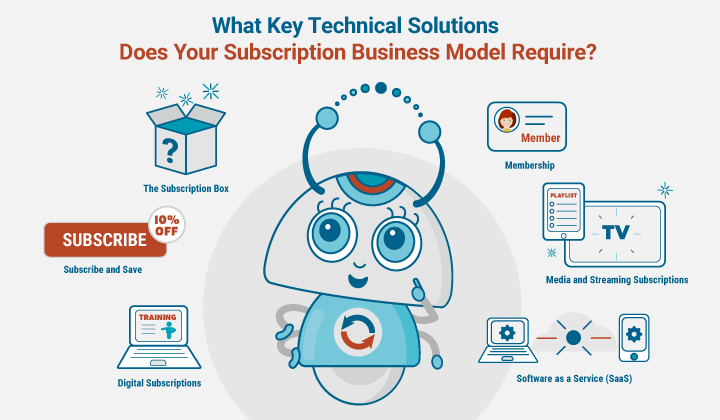6 B2B Subscription Business Models That Have Proven Their Market Profitability
 Igor Krasnykh
·
8 minute read
Igor Krasnykh
·
8 minute read

Business-to-Business (B2B) subscription business models continue to gain in popularity. With the use of the Magento 2 subscription extension the process is easier and more efficient.
This article is for you if:
- You want to see data that shows B2B subscription business models are lucrative;
- You want to learn about the different ways you could start generating recurring revenue;
- You would like to schedule a strategy session with an e-commerce expert to help determine the best path forward.
During the past decade, subscription commerce companies have experienced tremendous growth and higher returns on investment. According to the Subscription Trade Association (SUBTA), the global subscription commerce economy had a compound annual growth rate (CAGR) of 17.33% pre-pandemic and continues to trend up.
SUBTA compares that number to the five-year CAGRs of Apple (9.2%), Microsoft (7.7%) and Amazon.com (20.8%). The numbers are included in the organization’s 2019 State of the Subscription Commerce Economy Annual Report.
The global subscription economy makes up 18% of the $41 trillion credit card processing industry, and SUBTA reports that 75% of direct-to-consumer (D2C) organizations will offer a subscription commerce business model by 2023.
How a B2B Subscription Business Model Works
Just like regular customers who have products delivered to their homes, businesses have recurring needs as well (think office supplies). The products, services and softwares businesses subscribe to on an ongoing basis are B2B, or business-to-business, transactions.
B2C stands for business-to-customer, and that’s when individuals purchase items for personal use. Understanding these unique buying dynamics is key to fine-tuning sales strategies.
Here are a few B2B subscription business model examples:
- A marketing firm subscribes to the Adobe Creative Cloud to complete graphic design and videography projects in a robust software suite. This is a good example of an online B2B subscription business model;
- An office has an automatic recurring order of 10 reams of white printer paper that is delivered every month from OfficeMax;
- A doctor’s office subscribes to a daily cleaning service from Merry Maids.
For perspective, let’s take look at a few examples of popular B2C offerings:
- A busy mother sets up a weekly grocery pickup order from her local supermarket, which saves her time and stress.
- A dog owner subscribes to the Bark Box to keep their furry friend loaded up on toys and treats.
- A health enthusiast receives monthly supplements from a company that delivers automatic order replenishment through a subscription-based business model.
It’s important to know who your target audience is. Because businesses and individuals are quite different markets, the strategy for acquiring and retaining customers will vary.
B2B Subscription Business Model Ideas
With the data-backed potential of the subscription commerce model, more brands are brainstorming ways they can create different types of subscription models in B2B. Below are the six subscription business models to consider in modern business. Each section includes data from SUBTA’s report.
While this article’s focus is B2B subscription business models, please note that B2C and B2B subscription business models work on the same principle of monetization. Therefore, the types of subscriptions below can also be applied to the B2C sector.

1. The Subscription Box
These days, there seems to be a product-based subscription box to fill every need. The dollar shave club delivers razor blades and other grooming products to the doorsteps of more than 3 million customers each month. Nearly 3.5 million girls are eager to see which five beauty products will be included in their monthly Glam Bags from Ipsy.
Subscription businesses have even found ways to deliver their services across species. The Bullymake Box and Kit Nip Box offer special toys and treats for furry friends to enjoy.
When it comes to B2B subscription business models, companies have emerged that provide subscription boxes containing office supplies, snacks and indoor plants.
Subscription box facts:
- Globally, there are 7,000 subscription box companies. Of those, 70% are based in the United States;
- The United States is home to 18.5 million subscription box shoppers, and 35% of them have three or more subscriptions;
- Men take advantage of subscription boxes more than women. In fact, 42% of them have three or more active subscriptions (compared to 28% of women).
2. Memberships
Membership businesses provide access to their services for a recurring fee. Amazon Prime, Costco, clothing rental companies and fitness centers are examples of businesses that leverage memberships to turn big profits.
When it comes to B2B subscription business models, it’s common to see tiered levels of pricing that encompass small to enterprise-level companies. Some companies even offer special member pricing for certain groups. For example, a B2B subscription business might offer special membership discounts for veteran-owned businesses or non-profits.
Membership facts:
- Amazon Prime is a well-known membership-based subscription service. With more than 100 million members;
- Amazon is making a pretty penny on its Prime dues (which cost $119 per year when paid in full);
- For Amazon, customer memberships are a gift that keeps on giving. The incentives offered with Prime cause members to spend four times more on Amazon than non-Prime customers annually;
- The same goes for Costco. The membership-only warehouse chain had 90 million members in 2017 who paid $55 for an annual membership, earning them nearly $5 billion in membership fees alone. That does not include all the money customers went on to spend in-store once their memberships were active;
- The outlook for customer retention is good for successful membership brands. Costco sees an 80% member renewal rate, while Amazon sees 90%;
- Fitness centers are increasingly reaping the benefits of recurring membership fees. Nationwide, they have enjoyed a 4.94% CAGR during the past five years;
- There are about 36,000 membership-based exercise facilities in the United States with a total membership count of 61 million;
- Clothing rental is gaining popularity in the membership arena, with American Eagle, Ann Taylor, and the Banana Republic throwing their names in the hat with StitchFix and Trunk Club. Brands that offer clothing memberships see a 50% customer growth and a 100% increase in total customer spending.
3. Subscribe and Save
Like B2C businesses, B2B subscription business models can offer discounts with ongoing subscriptions. A customer who plans to purchase a product one time may be enticed to enter into a subscription if savings are offered. At least, that is the hope of businesses that offer subscribe and save subscriptions.
While one-time purchase options are still offered, customers can enjoy instant savings if they sign up to receive replenishment products at a lower price. For the customer, the allure of this model is the money that can be saved over the long term. While the average order value (AOV) may be lower, subscribe and save businesses enjoy a higher customer lifetime value (CLV).
Flexibility is a key component of a subscribe and save the business. They often give subscribers discounts, the option to skip a month, and the ability to change products.
Subscribe and save business model facts:
- Fifteen percent of online shoppers have signed up for one or more subscriptions to receive products on a recurring basis;
- Home, beauty, fashion, and coffee products have an average order value (AOV) of $30 or less;
- These categories have a churn rate of 10% (referring to customers who gravitate away from the products);
- Food, pets, and coffee are among the top product categories that attract high-value customers. These businesses often offer one-time purchase add-ons that increase AOV and are believed to reduce churn rates.

4. Media and Streaming Subscriptions
Subscription-based media is delivered through print, broadcast, and online. While publications were the first businesses to offer subscriptions, news media companies have struggled to keep readership in recent years. That is largely because free information is more readily available online.
While 16% of Americans are willing to pay for online news, 80% do not think it is worth it. Even with the odds stacked against them, The Times managed to turn its digital-only subscription base into a $1 billion business. The newspaper estimates that 62% of its revenue now comes directly from readers. SUBTA says a key strategy for media companies is to provide a valuable service at a low fee where the subscription can be terminated and reinstated at any time.
In the world of B2B subscription business models, a company may pay for a Spotify subscription so they can play ad-free music in their retail store. They may also subscribe to industry-specific programming that they can play on television screens inside their business.
Media and streaming subscription facts:
- Almost half of the survey respondents subscribed to an online streaming-media service such as Netflix;
- Once media companies land a subscriber, that person will be more likely to use the service more in order to get the full value;
- Sixty-eight percent of readers view only one article in a 30-day period, while only 9% view more than five.
5. Digital Subscriptions
Technology has paved the way for digital-only companies to emerge. It has also given traditional businesses an opportunity to expand their offerings with digital products. With 3 billion people using smartphones, businesses have found a profitable opportunity with apps. The on-demand taxi service Uber, for example, is used by more than 8 million people in 400 cities across 70 countries.
In the world of B2B subscription business models, a company may pay for digital training platforms — like LinkedIn Learning — to help advance employee development.
Digital subscription facts:
- The average person uses 9 mobile apps on a daily basis, spending an average of 2.25 hours a day on them;
- LinkedIn, which offers its premium services for a monthly fee, grew from 500,000 users to 530 million during a 13-year time span;
- Digital services are becoming more flexible, with 77% offering multiple plan types;
- Just 17% of digital services offer monthly subscriptions only;
- Annual-only plans make up 6% of digital services.
Software as a Service (SaaS)

SaaS describes the subscription-based licensing of software. It’s one of the most common examples of B2B subscription-based business models. With this service-based model, users access programs via a cloud network (rather than installing them on their computers).
As mentioned previously, one example of a SaaS product is the Adobe Creative Cloud. For a monthly fee, users can access more than 20 creative apps (such as PhotoShop, InDesign, and Premiere Pro). This is of value to customers because purchasing each app individually can cost thousands of dollars. Additionally, subscribers can benefit from real-time updates and feature upgrades.
There are five SaaS business structures used today:
- Flat-rate pricing: A single product with a set of features is offered at a set price;
- Usage-based pricing: The more a person uses the service, the more they pay;
- Tiered pricing: This is used when businesses offer multiple packages with different combinations of features at different price points;
- Per-user pricing: The fee structure is based on how many people are using the software;
- Per feature pricing: Users pay more according to the number of features they use.
SaaS facts:
- The median company in the Information Technology sector has a 5-year CAGR of 7.3%;
- Thirty-four percent of SaaS businesses offer free trial periods;
- The SaaS segment has seen the lowest churn rate of all the segments with the voluntary churn being 4.04%.
The Key Takeaway
While a one-time payment can bring businesses more money at once, a subscription commerce business model focuses on longevity. Recurring revenue can add up to more customer spending over time. Additionally, B2C and B2B subscription business models help drive customer loyalty as users come to depend on the value they provide.
Business is booming in the subscription world as brands get creative with rethinking their processes. Can your business incorporate a subscription commerce model to cast a wider customer net? If so, it’s time to start thinking logistics and infrastructure.
Whether you’re selling in the B2C or B2B subscription space, you’ll need to determine if your revenue will be collected on a weekly, monthly or annual basis. Also, will you provide the flexibility for your customers to conveniently manage their own subscriptions?
Of course, in order to successfully implement automatic order replenishment to your customers, you’ll ned to invest in upgrades to your tech stack. That’s where PowerSync comes in. If you’re a Magento merchant, or if you use the Salesforce CRM, PowerSync’s tools can empower your business to manage even the most complex order scenarios.
We invite you to click the button below to set up a risk-free consultation with one of our e-commerce experts today.
Consider PowerSync Your Trusted Partner
Maximize your profits with recurring revenue business model
PowerSync can help you maximize your ROI from Salesforce platform business investment:
- 20+ years of platform experience based on industry and platform best practices;
- Focused on growing YOUR profits through automation and overhead reduction;
- Prompt communication and short SLAs.
FAQ
Are B2B subscription boxes profitable?
Yes. The B2B subscription business model provides a way for businesses to cater to their customers’ ongoing needs. That equates to a reliable stream of recurring revenue.
How does a subscription business model function?
B2B subscription business models rely heavily on innovative tech solutions (like PowerSync’s Magento 2 subscription extension) to ensure a seamless customer experience from order to delivery.
What subscription business models mean for sales teams?
Ample opportunities lie within B2B subscription monetization models. That said, sales teams must focus on customer retention more than ever. Nurturing customer relationships, providing exclusive perks and ensuring top-notch support are ways to increase CLV.
What are the best B2B subscription business models?
Accordion When it comes to the best subscription business models for B2B, the answer will vary depending on the type of industry a business falls into. Therefore, you’ll have to do plenty of research surrounding B2B subscription business model facts and statistics. While a subscription box may work well for one company, tiered memberships may be a more lucrative B2B subscription-based business model for another business.




